Twelve Sons, Twelve Stones
by John P. Pratt
Reprinted from Meridian Magazine (3 Aug 2005).
©2005 by John P. Pratt. All rights Reserved.
Index,
Home
The twelve stones in the breastplate of the ancient Hebrew high priest can now
be identified, with the corresponding tribes of Israel.
The Lord instructed Moses to have the names of the twelve sons of Israel engraved on twelve
stones in the breastplate of the high priest. The exact order, arrangement, and type of each stone
was explicitly stated (Ex. 28:17-21), but the name to be written on each stone was not given,
perhaps because it was obvious to Moses. After the destruction of the temple, the knowledge of
which tribe was associated with which stone was lost, and even the identity of some of the stones has been uncertain. This article attempts to restore this lost knowledge by use of the birth dates of those
twelve sons, and the correspondence of those dates to the twelve zodiac constellations, as
presented in last month's article.[1]
1. Birthstones
Do you have any jewelry containing your birthstone? What is the origin of the birthstones? Are
they just a way for jewelers to peddle their wares, or is there really some significance to these
twelve stones? And if so, is it the chemical makeup of the stone that is important, or is it the color, or both? And should the stones be associated with months of our Gregorian year, or perhaps the Hebrew
months, or maybe the 30-day signs of the zodiac, or how about the actual zodiac constellations in
the heavens?
What about the colors associated with certain nations, such as the colors of their flags? Why are so
many of the flags of Europe colored red, white and blue?[2] What about the colors in heraldry, the colors on your family crest? Are they significant? What do colors have to do with families and nations?
 |
Figure 1. The high priest's breastplate contained twelve stones.
The origin of our twelve birthstones and their colors is rooted in the twelve colored stones in the
breastplate of the high priest of ancient Israel. The fact that our birthstones are not only associated with different tribes, but also with different months, shows that there was a strong tradition that each of the twelve sons of Jacob was born at a distinct time of year. So if our birthstones trace back to a Biblical origin, the question arises of just how accurate our modern list of birthstones is.
1.1 The Problem
Unfortunately, we have known neither the stones nor the associated tribes, much less the time of
year for each stone. One of the long unsolved mysteries in the Bible is the identification of the
twelve stones in the breastplate of the high priest. Most of those stones are mentioned only in that
context, and so they have been extremely hard to identify. Most scholars have given up the
identification as a lost cause. Many lists have been published, purporting to be authentic, but in
fact they are based only on speculation, such as assuming that the order of the stones is the birth
order of the sons.[3]
As an example of the confusion of the translation of the stone names, the fourth stone is called
"emerald" in the King James version, "carbuncle" in the Greek translation (Septuagint),
"turquoise" in the New American Standard version, and "garnet" in Strong's dictionary. Note that
the colors of those modern stones are all different (green, red, blue, blackish red), so we end up
confused both on colors and stones. To add to the confusion, many stones come in a variety of
colors: Sapphires are not just blue, they are also colorless, pink, orange, yellow, green purple and
black.[4] And another problem is that some of the ancient names which we recognize, used to refer to
different stones. For example, before medieval times, "sapphire" referred to the blue stone lapis
lazuli for at least many centuries.[5] So it has appeared to be a hopeless tangle of yarn that no one has been able to unravel.
 |
Figure 2. The twelve stones each had a name engraved on it.
These, however, are some of the most difficult examples. The colors of some stones in the list are
perfectly known, such as the first one, odem, which means "red" in Hebrew. In other cases, all
translators agree on the identification of the stone, such as topaz and amethyst. They might all be
wrong, but at least there is a consensus.
1.2 The Solution
This paper attempts to provide a definitive correlation of all twelve stones to their modern
names, colors, and tribes of Israel. The solution is based on using information from two other
sources: birth dates and birth constellations.
First, as mentioned above, the fact that there is a strong tradition that each of the twelve stones is
associated with the time of birth of one of the twelve sons of Jacob is a big clue. Sometimes a general
idea is preserved over time while the details are lost. The fact that each stone is associated with a
different month and also with a tribe of Israel definitely indicates a tradition that it was the time of
birth of those twelve sons that identified them with a specific stone. Last month a list of birth
dates, derived from sacred calendars, was proposed for each of the twelve sons of Jacob. They
were spread out during the year, which agrees with this tradition.
Secondly, that same article also identified each tribe with a constellation of the zodiac. That is also
a big clue to solve the puzzle, because the Lord apparently also alludes to several of the constellations as
the same precious stones of the breastplate of the high priest. He said to the prophet Ezekiel,
Thou hast been in Eden the garden of God; every precious stone was thy
covering, the sardius, topaz, and the diamond, the beryl, the onyx, and the jasper,
the sapphire, the emerald, and the carbuncle, and gold: the workmanship of thy
tabrets and of thy pipes was prepared in thee in the day that thou wast created.
(Ezek 28:13).
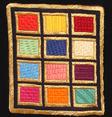 |
Nine of these stones covered Eden.
Those nine stones are nine of the twelve stones of the high priest. The fact that he says the stones
were the "covering" in the Garden of Eden, suggests that he might be referring to the canopy of the
heavens, and that each of those stones is associated with a zodiac constellation. This argument is
not compelling, but if this suggestion is not correct, then just what does the scripture mean? The
scriptures do tell us that some of these stones were found in the Garden (Gen. 2:12), but when so
many of the stones are listed as a "covering," it seems more likely that it refers to the heavens.
Let us now use these two new lists of birth dates and constellations to identify the stones. Those
who wish only to know the answer can skip the somewhat detailed derivation which follows to
Table 4 near the end of this article.
2. Unravelling the Mystery
Let us now solve the mystery of the stones one step at a time. The solution is based upon a few
postulates.
2.1 Postulates
1. Twelve Tribes. The twelve stones in the breastplate correspond to the original twelve sons
of Jacob, not to the tribes of Ephraim and Manasseh, which were later adopted as sons, effectively doubling the inheritance for their father Joseph. That seems to be implied in the text.
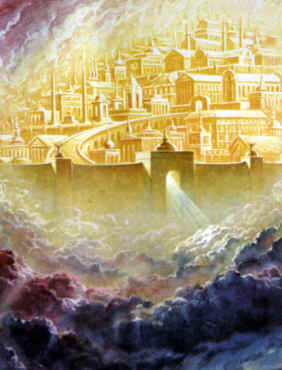 |
New Jerusalem has walls of jasper.
2. Twelve Foundations. The twelve foundations of the New Jerusalem are garnished with the
same twelve precious stones, as named by John the Revelator (Rev. 21:19-20). While those
stones are associated with the twelve apostles, they are also near the twelve gates which are named
for the twelve tribes of Israel. This postulate is perhaps the most important, because John is
writing in Greek some fifteen hundred years after Moses. He is referring to stones which he
recognized and understood. Because Greek is so much better known, and those words can be
found in so many other documents, this postulate greatly simplifies the problem.
You might ask yourself how well you know gem stones. Suppose you had had the revelation
given to John. How would you have described the foundation stones? Most of us know that
rubies are red and emeralds are green, but perhaps not much more. Apparently John knew his
gems well, right down to recognizing sardonyx as a specific form of onyx.
3. Twelve Colors. It is proposed that it is the twelve colors of the stones which are most
important, and that representative stones were chosen for those colors. The stones had to be large
enough to engrave the names of the tribes upon, whereas in other contexts, such as a gem inlaid in
a ring, a smaller, more precious stone could be used to represent the tribe equally well.
4. Twelve Constellations. It is also proposed that the twelve zodiac constellations each had a
unique color for the figure and that the twelve stones also corresponds to those colors. This
postulate is a key element which will allow some of the most difficult relations to be discovered.
5. Order. The final order discovered should make sense. That is a vague requirement, but
God's house is a house of order, and the order certainly will not be random. The trouble is,
almost every time the twelve tribes are listed, they are given in a different order (Gen 27, 49; Num
2; Deut 33; Rev. 7). The names of the tribes were also engraved on stones on the shoulders of the
priest, with six on each shoulder according to their birth (Ex. 28). That would be the most logical
order to assume for the twelve stones on the breastplate, and indeed, that is usually the case in
most studies, as shown in Figure 2.[6] This study will not require birth order, but at least some sort of reasonable order.
2.2 Hebrew Names
Let us proceed step by step, making sure the ground is firm beneath our feet before each new step
is taken. One mistake could lead us down a false path. Table 1 lists the stones in order by Hebrew
name in the first column and the King James translation in the second. The third
column lists the name used in the Greek translation of the Bible done in the third century BC (called the Septuagint). That
is extremely important because it gives us the understanding of the Hebrews at that time of the
meaning of the stones. We still use nearly all of the same Greek names today to refer to the same
stones, so if that translation were totally correct, we would just about have the entire answer we are
looking for. The final column lists other places in the Old Testament where the name of the stone is
used again to describe a color. Unfortunately there are very few such references; most of the stone
names appear only in the context of being a precious stone, which doesn't help distinguish one
from another. There are three lists in the Old Testament of these stones: 1) when the Lord instructs
Moses how to fashion the breastplate (Ex. 28:17-20), 2) when the breastplate was completed (Ex.
39:10-13), and 3) in a revelation to Ezekiel, when the Lord compares the Garden of Eden's
"covering" with nine of these twelve stones, given in a different order (Ezek. 28:13). None of
those three references helps us identify the stones, except that some of the meanings refer to colors.
The stones mentioned in only those three places are listed with "none" in the column for other
references.
| Hebrew Name | King James | Septuagint | Color | Other Refs. |
|---|
| 1. Odem | Sardius | Sardius | red | "red" (Hebrew); not ruby, which
is "paniyn" (Lam. 4:7) |
| 2. Pitdah | Topaz | Topaz | topaz | from Ethiopia (Job 28:19) |
| 3. Bareqeth | Carbuncle
(Garnet) | Emerald | green? | color of "lightning," (Dan. 10:6),
"green" (Greek) |
| 4. Nophek | Emerald | Anthrax
(Garnet) | red-black | precious, Ezek 27:16, "coal"
(Greek) |
| 5. Sappiyr | Sapphire | Sapphire | blue | sky blue, Ex. 24:10 |
| 6. Yahalom | Diamond | Jasper | many | none |
| 7. Leshem | Ligure | Ligure | ? | none; ligure is unknown |
| 8. Shebuw | Agate | Agate | many | none |
| 9. Aclamah | Amethyst | Amethyst | purple | none |
| 10. Tarshish | Beryl | Chrysolite | yellow | color of heavenly chariot wheels
(Ezek. 1:16, 10:9 ); color of a
heavenly man's body, whose
face was like lightning (Dan
10:6) |
| 11. Shoham | Onyx | Beryl | white | "whiten" (Hebrew); on high
priest's shoulders (Ex. 28:9) |
| 12. Jashepheh | Jasper | Onyx | many | none |
Table 1. Hebrew names of the Twelve Breastplate stones.
Now let's see what we can learn about the identity and colors of the stones from this table.
 |
Odem, meaning red, refers to the sard.
Odem (Red). The first stone odem means "red" in Hebrew[7] and nearly all translations agree
that it refers to a sard (also called sardius), which is a very red stone. Note that while some
translations list this stone as a ruby,[8] one would be hard pressed to find a ruby large enough to
engrave a name on, and even then it would require a diamond to write it. Moreover, most rubies
are not as red as sard. Thus the first stone and color are well-identified. If all of the stones were
this easy, the puzzle would have been solved long ago.
 |
Sapphire represents blue.
Sappiyr (Blue). Our word sapphire comes from the Greek, which in turn comes from the
Hebrew sappiyr. At the time of John the Revelator, the name referred to lapis lazuli, a very blue stone. The confirmation that the ancient stone was also blue comes in a vision at the time of Moses, when the Lord appeared on a pavement of sappiyr, described as being as blue as a clear blue sky (Ex. 24:10).
 |
Amethyst is a deep purple.
Aclamah (Purple). All the translations agree that aclamah refers to the amethyst and there seems to be almost no doubt about this identification. While the scriptures don't specify that the
color is purple, that is the only color of amethyst.
 |
The second stone is topaz.
Pitdah (Yellow Brown). The other stone on which all translations agree is that the second
stone pitdah is the topaz. Although topaz comes in many colors, the principal color associated with the most common variety is a very light yellowish brown color. That is almost certainly the color
implied for this stone.
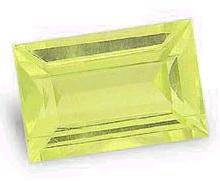 |
Chrysolite was yellow, like this chrysoberyl.
Tarshish (Yellow). This stone is most likely a golden color, matching the translation in the
Septuagint of chrysolite ("golden stone" in Greek). It is the color used by Daniel to describe a man
seen in heavenly vision, whose face is described to be like lightning (Daniel 10:6). The name of the third stone is derived from that same word for "lightning" and is presumably a similar golden color. The name Tarshish is the same as the Mediterranean country (Jonah 1:3, probably Spain) and hence
also came to mean "Merchant Vessel" (see 2 Chron. 9:21, Psalm 48:7, Isa. 23:1).
 |
Beryl symbolized white or clear.
Shoham (White). The eleventh stone shoham almost certainly refers to a white stone because the root of the name means "to whiten."[9] It has been translated both as onyx and beryl, both of which have white varieties.
Thus, only six of the stones are clearly identified with colors by the stone itself, by other passages
or by name derivations. Note also that there are some serious questions about some of the King
James translations. "Diamond" almost certainly is not correct because nothing would be available
hard enough to inscribe the name into it, and it would have the be a very large diamond! The name
"jasper" was probably chosen only because it is similar to the Hebrew word. Nine of the names of
the stones only appear in the context of being a precious stone, with no clues at all to color or other
identifying characteristics. So let us now turn to other clues.
2.3 Greek Translation
In the third century BC the Old Testament was translated into the Greek version called the Septuagint.
At that time, the temple at Jerusalem was functioning, and the breastplate was not just a memory,
but was actually used by the high priest. This translation is extremely important because Greek
words were used to describe those gems, words which should give us excellent understanding
of just what stones are implied. Many of our words for minerals today derive directly from these
very Greek words. We must be cautious because many have changed in meaning, but they give us
a big step up in understanding. Let's consider what is implied about the colors of the stones.
Known Colors. Several of the stones have known colors, either because the Greek word
includes the color name, or is synonymous with that color, or because the stone is well known and
only comes in one color. As listed in the table, the known colors are: sardius is red, emerald was a
synonym for green, sapphire was a synonym for blue, amethyst only comes in purple, "chrysolite"
means "golden stone" or "yellow stone," and beryl meant only the white or cream colored variety.
Unknown Colors. On the other hand, jasper, agate, and onyx come in a variety of colors, and
often are striped. And to complicate the issue, the meaning of the Greek "ligure" has been entirely
lost. While that word is used in English, as in the King James version, it's meaning is unknown,
but it is usually associated with the jacinth. Now let us consider other color considerations.
Bareqeth (lightning or green?). The third stone bareqeth derives in Hebrew as the same word for
"lightning," supposedly because it represents the same color. For example, Daniel compares the
facial color of a man he saw in vision to that of lightning (Dan. 10:6). But the Greek translation is
"emerald," which was synonymous with "green" in Greek. Most people would not say lightning
is green, and we could hardly think of an angel with a countenance like lightning as having a green
face. The solution to the problem proposed in this article explains both translations.
 |
Carbuncle (glowing coal) usually means garnet.
Nophek (reddish black). This stone is a great key to the entire puzzle, which I discovered
only after I had solved it the hard way. The Greek translation of nophek is "anthrax," which in turn is translated as "carbuncle" into English. Both are said to mean a dark red stone. "Carbuncle" also
refers to red, inflamed boils, and the sheep disease "anthrax" was supposedly named for the dark
red streaks and spots which appear. My research showed me that this was definitely correct and
that the stone must be a dark red color as a substitute for pure black, the color of the tribe of
Dan,[10] and probably refers to the garnet.
The origin of both the words "anthrax" and "carbuncle" describes the color implied very well.
Carbuncle comes from the word "carbon," meaning coal, with the "cle" on the end meaning "little,"
like a "particle" is a "little part." What was implied was the idea that it was a hot, "glowing coal,"
in the sense that one might speak of barbecuing over the hot "coals" of a fire. Similarly, "anthrax"
also means "glowing coal." We still use that Greek root in our word "anthracite" coal. One
dictionary definition of "carbuncle" is "deep-red garnet," deriving the word as meaning "glowing
ember," which indeed described the color of many garnets perfectly.
"Glowing ember" also exactly matches the description of one of the foundation stones, as
described in the next section, which greatly simplifies the puzzle. Just for the record, I only
looked up these meanings after I had solved the puzzle the hard way, so to me this derivation
comes as comforting confirmation that the solution is correct. It is a lesson in the importance of
understanding the origin of words.
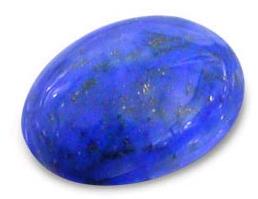 |
The royal blue lapis lazuli.
Sappiyr (blue). The meaning of sapphire has clearly changed over the centuries. All agree
that sapphire referred to stones of a blue color, but the exact meaning is unclear. The Greek word sapphire was derived from the Hebrew sappiyr (stone #5). Fortunately, we have a clear reference of exactly what color was indicated. The Lord appeared on a sappiyr colored pavement to the seventy with Moses, which was compared to the color of a clear blue sky (Ex. 24:10). The Greek word
sapphire referred to lapis lazuli, which is a royal blue stone. And today in English sapphire refers
to an entirely different blue stone and even to stones of other colors.
 |
New Jerusalem has walls of jasper.
2.4 Foundation Stones
Now let us look at the twelve stones that John describes as forming the foundation of the New
Jerusalem. All of the twelve Greek stone names are essentially identical to names still used today
to describe semi-precious stones, so they are much better understood than the ancient Hebrew
names. According to Postulate 2, they should be identical to the twelve breastplate stones, or at
least be stones of the same colors.
The twelve foundation stones are listed in alphabetical order in Table 2. The order given in
Revelation apparently corresponds to the twelve apostles (Rev. 21:14), and that is not the subject
of this article. Let it now suffice simply to correlate the stones to the twelve tribes of Israel.
| Greek | Modern Stone | Color | Other Refs. |
|---|
| Amethyst | Amethyst | Purple | none |
| Beryl | Beryl | White or Cream | none |
| Chalcedony | Chalcedony | Light Blue | none |
| Chrysolite | Chrysolite | Yellow (Gold) | "golden stone" |
| Chrysoprase | Chrysoprase, Peridot | Yellow Green (Gold) | "golden leek" |
| Emerald | Emerald | Green | "green" |
| Jacinth | Jacinth (Hyacinth)
or Garnet | Reddish Black | color of smoke,
Rev. 9:17 |
| Jasper | Jasper | Orange or
Fiery Red | Yellow-Red, Rev. 4:3
& Ezek. 1:27. Walls
of New Jerusalem,
Rev. 21:11,18. |
| Sapphire | Lapis Lazuli | Royal Blue | "blue" |
| Sardius | Sard | Red | "red" Rev. 4:3 |
| Sardonyx | Sardonyx | Red & White layers | none |
| Topaz | Topaz | Yellow Brown | none |
Table 2. The Foundation Stones in alphabetical order, with colors
If we compare these twelve stones to those given in the King James translation, we find that eight
of them agree (if we equate sardonyx with onyx). But before we get too excited about believing all
the correlations, we need to remember that the King James translators had no clue (literally) as to
what many of the stones names referred to. Often, they simply picked the name of a modern
precious stone (like "diamond") to use in the translation.
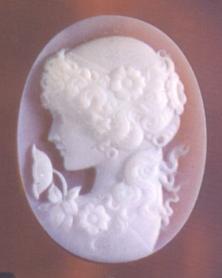 |
Cameo carved from sardonyx.
Three new stones. If we compare these twelve Greek names for the foundation stones to the
Greek translations of the breastplate stones given in the Septuagint, we find that nine are identical.
That is very encouraging because the Greek Septuagint translation was done some three centuries
before John wrote Revelation. It is the fact that most of them are the same which lends credence to
Postulate 2, that all twelve must correspond. The remaining three stones mentioned in Revelation
which thus need to be matched with the Hebrew names are chrysoprase (yellow-green),
chalcedony (light blue), and jacinth (also called hyacinth, referring to either a red or blue form of
zircon). Gem books note that the original meaning of jacinth is unclear. The modern meaning
refers to a yellow-red to red-brown from of zircon, but many believe that the ancient stone was
blue. The three stones on the Greek breastplate list which are not on the foundation list are
carbuncle, ligure, and agate. The two stones of onyx and sardonyx can probably be safely
equated because sardonyx is merely a special form of onyx in which the layers are alternately red
and white. Sardonyx is used for making cameos, by cutting away one colored layer to form a
background for the picture. Thus, specifying "sardonyx" indicates the colors, because onyx can
come in many colors, including not only white, but also black.
Jacinth is Carbuncle. In Greek, jacinth sometimes refers to a dark red color and sometimes a
dark blue. There is one scripture that seems to tip the scale as to what color the stone "jacinth"
represented to John the Revelator. He states,
And thus I saw the horses in the vision, and them that sat on them, having
breastplates of fire, and of jacinth, and brimstone: and the heads of the horses were
as the heads of lions; and out of their mouths issued fire and smoke and brimstone.
(Revelation 9:17)
Here we are told the horsemen had breastplates of fire (red), jacinth (?), and brimstone (sulfur or
yellow). But then in a parallel construction we are told they breathed out fire, smoke, and
brimstone. That construction strongly suggests that the color of jacinth corresponds to the color of
the smoke accompanying the fire. That favors the dark red interpretation. Moreover, now that we
know the meaning of "carbuncle," it is a perfect with the idea of "glowing ember" because smoke
often contains glowing sparks. So let us equate jacinth to carbuncle (Greek anthrax).
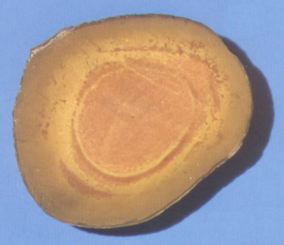 |
Yellow Jasper (silex) has red streaks.
Yellow/Red Jasper. The stone Jasper comes in a wide variety of colors, but John gives us
enough clues to deduce that it is the yellow variety with red streaks (silex) which is indicated. The
being on the throne is described by John as being the color of sard and jasper (Rev. 4:3). Sard is
red, but what color is jasper? Fortunately, in a parallel revelation given to Ezekiel, the being is
described as colored like amber (yellow) filled with swirling fire (red) in the upper body,
and like fire in the lower (Ezek. 1:27). So here again a being with two colors is described, even as
John compared the colors to two stones. Clearly the red fire corresponds to sard, which leaves the
red swirling within yellow to be the jasper. As shown in the illustration, that exactly describes one
kind of jasper. Note that this fills in the color wheel area for "orange," but does so in a more
picturesque fashion than the simple color orange. Similarly, the opal with an orange color is called
the "fire opal" which serves well as a gem of this color.
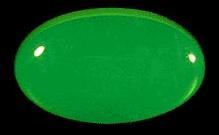 |
Chrysoprase is yellow-green.
Golden-green Chrysoprase. One of the new stones on John's list is chrysoprase, which
means "golden-green" or "yellow-green" in Greek. This color fits well to be that of bareqeth (stone
#3) which was described both as like "lightning" (a golden color) and also as green (emerald). Let
us tentatively make this identification, which refers to the modern gem stone peridot or olivine.[11]
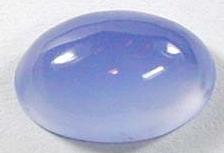 |
Chalcedony is light blue.
Sky Blue Chalcedony. There are two sacred colors of blue in the scriptures and there are two
blue stones of those colors, so let us match them. John adds chalcedony to the list, which is a light
blue (sky blue) stone. The other blue stone he lists is called sapphire in Greek, which during his
time referred to the stone we call lapis lazuli, which is a royal blue color. In the Old Testament, the
stone sappiyr is compared to the azure blue sky, so let us equate that stone to chalcedony.
Royal Blue Ligure. In the
temple, the blue color used for the high priest's robe (Ex. 28:31) was a royal blue color which
exactly matches that of lapis lazuli (see Figure 1). Let us equate the unknown Greek "ligure" to
lapis lazuli. Most translators equate ligure to the blue form of jacinth (blue zircon), but that would
yield too many blue stones. I propose that about 280 BC, when that Septuagint was translated,
that the Greek "sapphire" referred to the azure blue chalcedony, the color of sappiyr. Nearly four
centuries later when John wrote, I propose that the Greek word sapphire had changed in meaning
to refer to the deeper blue lapis lazuli. That seems like a reasonable conjecture, and as will be seen
in the final order, it is apparently an important key to unlocking the order of these stones.
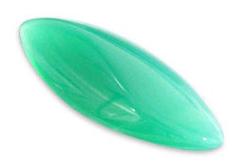 |
Agate can be light or dark green.
Green Agate. By elimination, we are left to equate the Hebrew shebuw, translated as "agate" in the Septuagint, with the stone John describes as emerald. Is that reasonable? It is, because agate refers to any of a wide variety of colors of quartz rock, named more for their stripes or variegated
patterns than for their color. One green form of agate is called moss agate, which could be the
foundation stone. Another possibility is called "emerald quartz." Let's try equating agate to green
and see how well everything fits together.
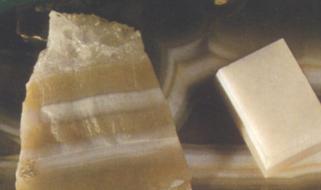 |
Sardonyx has alternate red and white layers.
Red/White Sardonyx. It is worth noting how much information was added by John the Revelator when he named one stone as "sardonyx" rather than merely onyx. Onyx refers to a layered rock which usually has white, red, or black layers. Sometimes it is all white or all black, so the name onyx alone does not specify color. But the variety with alternate red and white stripes has the specific name "sardonyx." Sardonyx is used to make cameos by carving out one layer to leave a raised picture. The same is done with onyx made of black and white layers of stone.
Table 3 lists the twelve breastplate stones with their Greek translations from the Septuagint, along
with the proposed correlation to the twelve foundation stones, and also to gems of similar color.
| Hebrew | Greek | Foundation | Gem | Color |
|---|
| 1. Odem | Sardius | Sard | Ruby | Red |
| 2. Pitdah | Topaz | Topaz | Topaz | Tan |
| 3. Bareqeth | Emerald | Chrysoprase | Peridot | Yellow green
(Golden) |
| 4. Nophek | Anthrax | Jacinth | Garnet | Reddish
black |
| 5. Sappiyr | Sapphire | Chalcedony | Aqua-
marine | Light Blue |
| 6. Yahalom | Jasper | Jasper | Fire Opal | Orange |
| 7. Leshem | Ligure | Lapis Lazuli | Sapphire | Royal Blue
|
| 8. Shebuw | Agate | Emerald | Emerald | Green |
| 9. Aclamah | Amethyst | Amethyst | Amethyst | Purple |
| 10. Tarshish | Chrysolite | Chrysolite | Chrysoberyl | Yellow |
| 11. Shoham | Beryl | Beryl, Onyx | Diamond,
Beryl | White |
| 12. Jashepheh | Onyx | Sardonyx,
Rose Quartz | Pink
Tourmaline | Red/White
stripes, or
Pink |
Table 3. Identification of the Twelve stones and colors.
Now let us turn to matching these colors to the constellations.
3. Constellation Colors
The classic constellations were associated with colors, some of which have been explicitly
recorded from antiquity. Others can be deduced, and some are related to the roles of Jesus Christ,
which were discussed in an earlier article.[12]
Cornerstone Constellations. The colors associated with the four "cornerstone" constellations
are the best established, and were discussed in detail in an earlier article.[13] They are that the Lion
is red, the Scorpion is black, the Water Bearer is blue, and the Bull is white. All four of those
colors show up in the colors of the stones, choosing the royal blue color, which was one of the
four principal colors used in the temple. The black would correspond to the red-black of garnet,
which makes a more beautiful stone than a straight black color. Similarly, a clear stone like
diamond can probably be substituted for white.
 |
One of the Fishes (Pisces).
Purple Fishes. The four colors of the temple were red, blue, white and purple. The colors of
the four cornerstone tribes are red (Judah), blue (Reuben), white (Joseph) and black (Dan). It
appears that the four temple colors represent the four cornerstone tribes, and hence all of Israel,
except that for some reason purple was substituted for black. I propose that such is the case,
perhaps for the reason that black is not a good temple color (it also having the connotation of evil,
like the black scorpion), and hence another tribe's color was substituted into its place. What is the
logical tribe to use for temple work? Is it not Levi, whose tribe was dedicated to temple service?
To me it seems clear that purple must be Levi's color. The constellation associated with Christ's
role as the Great High Priest is the Fishes (the two fish representing his church), and the high
priest was chosen from the tribe of Levi. Thus, purple is the proposed color of the fishes.
As long as we are noting that sometimes black is dropped from the four colors representing Israel, the suggestion arises that this might explain why the colors red, white and blue are so common in the flags of Europe, where scattered Israel migrated.
Golden Ram and Scales. The Ram was often called the Ram with the Golden Fleece, and the
ancient Greek authority Homer referred to the Scales as the "golden scales."[14] There are two "golden"
colors in the constellations, one being yellow and one yellow-green. Let us associate those two
colors with those two constellations, with the option of switching them if the resultant order
requires it.
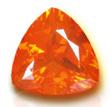 |
Fire Opal can be orange like jasper.
Fiery Archer. The archer almost certainly needs to be the fiery orange color described for the
heavenly beings. The Archer has wings in the older pictures, such as that at Dendera in Egypt,
but in the modern pictures, taken from the Greek, the wings were mistaken for a cloak flowing in
the breeze above the Archer.
Tan Crab. The light yellowish brown (tan) color of topaz matches the color of the Fiddler
crab very well, and hence is proposed as a tentative identification. It also matches a common color
for the donkey, which is also associated with these stars.
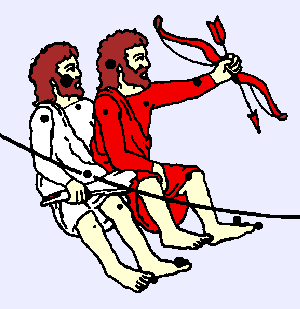 |
The red and white Twins.
Red/White Twins. Let us match the red and white stripes of sardonyx with the Twins for two
reasons. First, the twins are associated with the first and second coming of Jesus Christ. He is
usually shown in white in pictures of his first coming, and yet he will be dressed in red at his
second coming (Rev. 19:13). Moreover, the Twins are the constellation of Benjamin, and that
tribe was split into two halves, part going with Judah (red) and part with Ephraim (white). And finally,
the red and white stripes so common in flags (including the U.S.) may tie to Benjamin.
 |
Emerald symbolizes green.
Green Sea-Goat. By elimination, the last constellation of the Sea-Goat must be matched with
the color green. That is not unreasonable because green is a color that can fit the sea, which is
often a blue-green color, and also the land with green plants.
Let us now list this tentative correlation in a table, along with the tribes of Israel which correspond
to these twelve constellations, from last month's article.
| Hebrew | Foundation | Color | Zodiac | Tribe |
|---|
| 1. Odem | Sard | Red | Lion | Judah |
| 2. Pitdah | Topaz | Tan | Crab | Issachar |
| 3. Bareqeth | Chrysoprase | Yellow Green | Ram | Zebulon |
| 4. Nophek | Jacinth | Red Black | Scorpion | Dan |
| 5. Sappiyr | Chalcedony | Light Blue | Maiden | Naphtali |
| 6. Yahalom | Jasper | Orange | Archer | Gad |
| 7. Leshem | Lapis Lazuli | Royal Blue
| Water Bearer | Reuben |
| 8. Shebuw | Emerald Quartz | Green | Sea-Goat | Simeon |
| 9. Aclamah | Amethyst | Purple | Fishes | Levi |
| 10. Tarshish | Chrysolite | Yellow | Scales | Asher |
| 11. Shoham | Beryl | White | Bull | Joseph |
| 12. Jashepheh | Sardonyx | Red & White | Twins | Benjamin |
Table 4. The Twelve stones, colors and tribes.
4. The Order
What is the order of these stones? That is, what is the order of the tribes as listed in Table 4?
Before considering this, note that many commentators assume is that they must be listed in order of
birth date, and they assign Reuben (the first born) to odem, and so on, and consider the problem solved by assumption. This conclusion probably comes from the fact that on the shoulders of the high
priest, the names were engraved with six names on each of two (white) beryl stones, with six on
each stone, "according to their birth" (Ex. 28:10). Let's examine even that meaning before
proceeding.
4.1 Shoulder Stone Order
When Moses was told to list the twelve tribes on the two shoulder stones "according to their birth,"
what did he understand that to mean? Was it strictly in order by birth date? A careful reading of
Genesis 29-30 shows that the actual of order of birth of the twelve sons of Jacob is not even given.
Rather, what is given is the order of birth by wife. That is, the order of birth of Leah's six sons
was Reuben, Simeon, Levi, Judah, Issachar, and Zebulon. Similarly, the order of birth of
Bilhah's sons were Dan and Naphtali, of Zilpah's sons were Gad and Asher, and of Rachel's sons
were Joseph and Benjamin. If you were Moses, how would you arrange these names onto two
stones with six per stone?
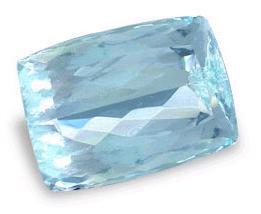 |
Aquamarine is light blue like chalcedony.
If you say that you would put Leah's six children all on one stone, with the others on the other
stone in the order just listed, then you agree with the standard Jewish interpretation. To me, that is
almost certainly correct. It is the order in Genesis, except that all of Leah's children are grouped
together, and it just seems to make to most sense to group both by family and order of birth.
Another nice touch is that if the priest faced east (the sacred direction), then his right shoulder
would face south, which was Reuben's direction, and the left should would be north, which was
Dan's direction. Thus, the stone on the right shoulder would start with Reuben's name with Dan
leading the list on the left shoulder. That also fits with Reuben being the firstborn, which is
associated with the son of the right hand. We know that because of his actions, Reuben lost that
blessing of being the firstborn, but that does not change the birth order.
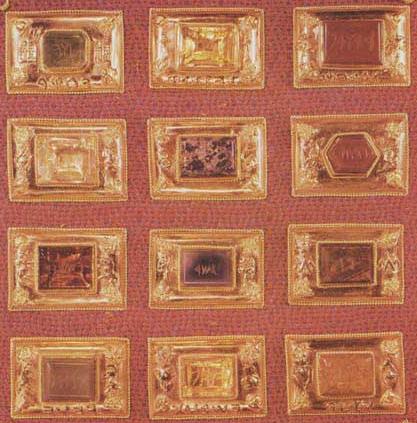 |
Figure 3. Breastplate reconstruction by A. Paul Davis.
This shoulder stone order is usually assumed to be the same order as the stones on the breastplate. The reproductions shown in both Figure 2 at the beginning of this article and Figure 3 here both have the names engraved in this order. Note that the first stone in both cases is in the upper right-hand corner of the illustration, consistent with Hebrew reading from right to left.
4.2 Encampment Order
In support of this shoulder order interpretation, consider the order of their names when the tribes
encamped in a square fashion, with three tribes in each direction. The order given is Judah,
Issachar, Zebulon (east), Reuben, Simeon, Gad (south), Ephraim, Manasseh, Benjamin (west),
and Dan, Asher, Naphtali (north) (Num. 2:3-29). What order are they listed in here? The order is
almost the same as just proposed for the two shoulder stones. Judah, Issachar and Zebulon are the
last three on Leah's stone in the same order. Why would Judah's three be listed first? Perhaps it is
because Judah is associated with the east, and east is the most important direction. Then Reuben,
Simeon and Levi would have been the next three, except that Levi was removed from this list when
he became head of the priestly tribe, which was protected in the middle of these armies. It would
make sense for Gad, the first born of Leah's handmaid Zilpah, to take Levi's place. If so, then the
next three are explained. Asher would then have moved up one place and we'd expect the north
three to be Dan, Naphtali and Asher. Those are the three encamped on the north, but I have no
explanation for why Naphtali and Asher have their order reversed. Perhaps it has to do with when
the tribes actually migrated. Finally, the tribe of Joseph was split into Ephraim and Manasseh,
which perfectly explains the order of the west encampment. Thus, with the exception of the
Naphtali/Asher swap, the encampment order is perfectly explained by starting with the proposed
shoulder order and then replacing Levi. Note that the four "cornerstone" tribes of Reuben, Judah,
Dan, and Joseph (Ephraim) are each at the head of one of the four cardinal directions in the
encampment order. That is in agreement with their each being the leaders for that direction, and
their colors of blue, red, black and white representing those four directions.
4.3 Breastplate Order
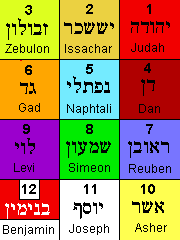 |
The names and colors in breastplate order.
Now we are finally prepared to consider the order proposed for the breastplate. Looking at Table
4, we see that the order is very similar to the encampment order, but before Levi was replaced. The
first three stones correspond to Judah, Issachar and Zebulon, exactly as in the encampment order.
The next three correspond to the north direction, being Dan, Naphtali, and Gad. This time the
three are still in the order expected from the shoulder order, rather than having Naphtali and Asher
swapped. The next three correspond to south in the exact birth order expected: Reuben, Simeon
and Levi. Finally the last three also are in perfect order: Asher, Joseph and Benjamin.
 |
Ruby is red like sard.
Another way to look at it is that the order is identical to the shoulder order broken into sets of three, and rearranged to have Judah head the list, as in the encampment order. Those readers who know Hebrew can see the order is the same as the traditional order shown in Figure 2, with the first row of three names moved down to the third row, and the next two rows moved up. So the order comes out
with only this slight modification from the standard Hebrew interpretation. That this
resultant order would match so closely what was expected, and that it was derived from
considerations about the colors of constellations and roles of Christ, is totally beyond chance.
Thus, it is proposed that Table 4 indeed lists the correct correlations of the stones to the
constellations, colors, and tribes.
5. Modern Birthstones
How does all of this relate to our modern list of twelve birthstones? Jewelers pretty much agree on
a list of ancient birth stones as correlated to months, and also have a similar modern list. They are
presented in Table 5 along with the months according to the actual birthdates proposed for the
twelve sons of Israel. The last column lists the gems proposed in this article to represent each of
the twelve constellations and tribes.
| Month | Modern | Ancient | Tribe | Birthday | Proposed |
|---|
| January | Garnet | Garnet | | | |
| February | Amethyst | Amethyst | Levi | 5 Feb | Amethyst |
| March | Aquamarine | Jasper | Zebulon | 4 Mar | Peridot |
| April | Diamond | Sapphire | Joseph | 6 Apr | Diamond |
| May | Emerald | Agate | Benjamin,
Issachar | 25 May,
29 May | Pink Tourmaline
Topaz |
| June | Moonstone | Emerald | Judah | 19 Jun | Ruby |
| July | Ruby | Onyx | | | |
| August | Peridot | Carnelian | Naphtali | 17 Aug | Aquamarine |
| September | Sapphire | Peridot | Asher | 23 Sep | Chrysoberyl |
| October | Opal,
Pink Tourmaline | Aquamarine | Dan | 9 Oct | Garnet |
| November | Topaz,
Citrine | Topaz | Gad | 2 Nov | Fire Opal |
| December | Turquoise or
Blue Topaz | Ruby | Simeon,
Reuben | 16 Dec
23 Dec
| Emerald
Sapphire |
Table 5. Modern, ancient, and proposed birthstones.
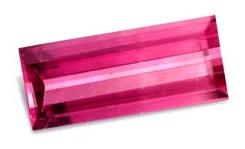 |
Pink Tourmaline can replace red/white sardonyx.
One thing to note from the table, which may be surprising, is that four of the modern stones seems
to be "correct" in that they match the proposed stones from this research. Amethyst for February,
Diamond for April, Ruby for July, and Blue Topaz for December all match the colors well. In the
table, Ruby (red) is associated with late June, but it really fits most of July well too. But that is
how the stones matched the birth dates 3,800 years ago when these 12 men were born. Let us
now discuss why that is not how they would be today.
5.1 Constellation Colors
Let us now return to the question of whether the stones correlate to months of our year, or of the Hebrew year, or to the 30
day "signs" used in modern astrology, or to the actual position of the sun in the zodiac
constellation at the time of birth. Using the twelve sons of Jacob as a model, the answer is, that it
is the actual position of the sun in the constellation at the time of birth which determines the stone.
Note from Table 5 that none of the proposed dates for the births of the twelve sons of Jacob
occurs in our modern months of January or July, nor is there one birth in each Hebrew month. Moreover, they do not all occur in the twelve
equal periods of astrological "signs" beginning about the 21st of each month. On the contrary, the
proposed dates of birth for Benjamin, Issachar and Judah all occurred between May 21 and June
21. But all twelve of the births do indeed occur when the sun is actually located in the zodiac
constellation associated with that tribe and the stone is the color of that constellation.
One motivation for me as an astronomer to solve this puzzle was simply to be able to create a color picture of the
zodiac constellations. Figure 4 is the result of this labor, with the position of the sun indicated for
the time of birth of each of the twelve sons of Israel. Note that the constellations are all different
sizes. That means not all stones get an equal length of time each year, but that the great
constellation of the Maiden has the most people born at that time, whereas the tiny Scales and Crab
have fewer who can claim those gems.
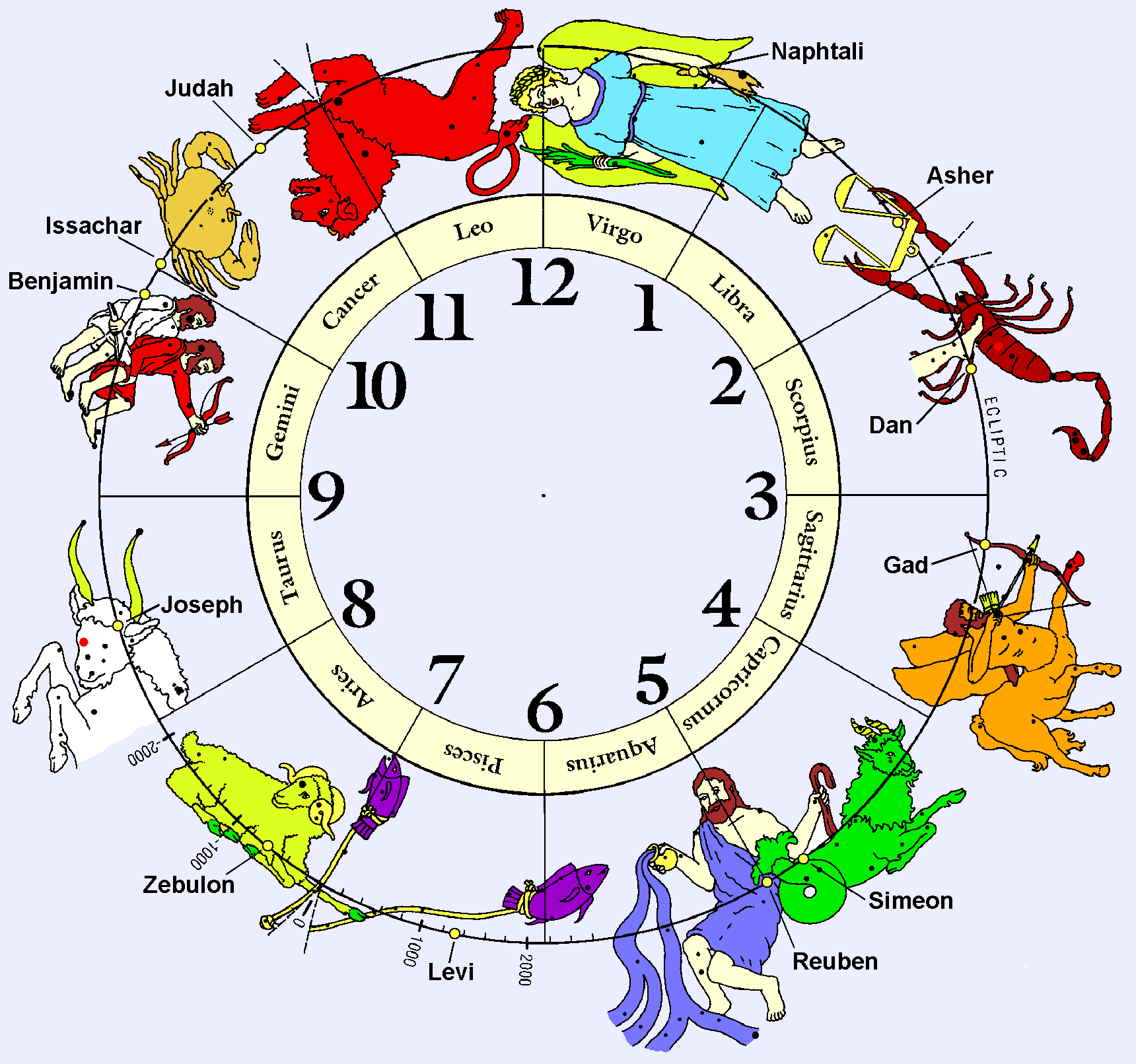 |
Figure 4. The Zodiac Constellations in the proposed colors.
5.2 Precession of the Equinoxes
Another matter which is bound to raise questions has to do with what is called the "precession of
the equinoxes." The north pole of the earth does not always point to the same place in the sky, but
rather it traces out a circle in the sky in about 26,000 years. That causes our solar year to shift
through the zodiac constellations by about one constellation every 2,160 years.
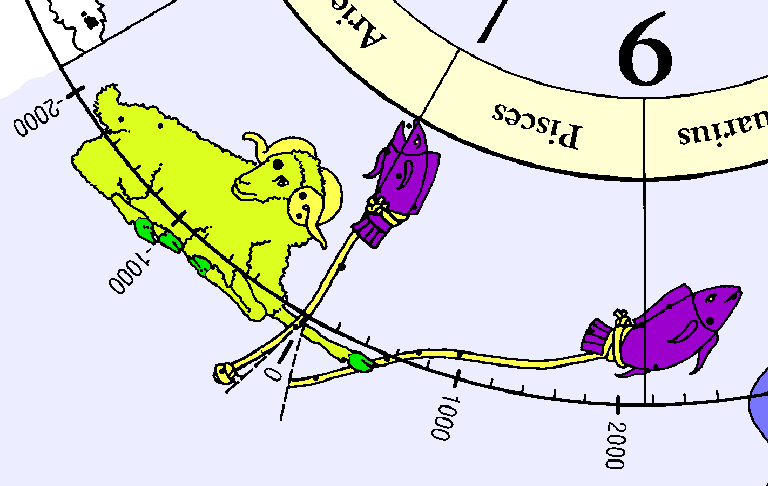 |
Figure 5. The sun's position at the spring equinox.
Figure 5 shows the position of the sun on March 21 (the spring equinox when the sun rises due east) from 2000 BC to AD 2000 on the small scale beneath Aries and Pisces. At the birth of Jacob's sons, the sun was in the Ram on 21 Mar, and then at the birth of Christ it moved into the Fishes, where it still is. Modern astrologers mostly use the "signs" (constellations) associated with a birth date back in ancient times. That is, they say a person in our day born in the 30 days beginning on March 21 is an "Aries" (Ram), whereas the sun was actually in Pisces (the Fishes).
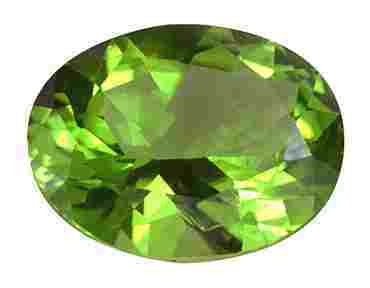 |
Peridot today is called chysolite, but is the color of chrysoprase.
5.3 Proposed Stones for Our Day
Some readers will want to know what the "true" birthstones are for our age, based on the current
position of the sun in the constellations. Because of the precession of the equinoxes, they would
differ by about two months from the "Proposed" column in Table 4 for the twelve tribes. That is,
the diamond (or beryl) would be the stone for those born when the sun was in the Bull, which would
now be from mid-May to mid-June rather than from late March to early April as at the time of these
patriarchs. It is not clear to me yet how to determine exactly where the boundary lines are between
constellations for this purpose, but I will venture a preliminary proposal. Judging from the birth
dates of these twelve tribes, it appears that the divisions between the constellations may be made
according to a calendar based on the 7-day week, such that the sun always enters a zodiac
constellation on a Sunday. Looking at the current position of the year in the zodiac the following
table should suffice for the current decade.
| Constellation | Begins
Sunday
on or
after | Length
(weeks) | Gem Stone |
|---|
| 1. Maiden (Virgo) | 12 Sep | 7 | Aquamarine |
| 2. Scales (Libra) | 31 Oct | 3 | Chrysoberyl |
| 3. Scorpion (Scorpius) | 21 Nov | 4 | Garnet |
| 4. Archer (Sagittarius) | 19 Dec | 4 | Fire Opal |
| 5. Sea-Goat (Capricornus) | 16 Jan | 4 | Emerald |
| 6. Water Bearer (Aquarius) | 13 Feb | 4 | Blue Sapphire |
| 7. Fishes (Pisces) | 14 Mar | 5 | Amethyst |
| 8. Ram (Aries) | 18 Apr | 3 | Peridot |
| 9. Bull (Taurus) | 9 May | 6 | Diamond |
| 10. Twins (Gemini) | 20 Jun | 4 | Pink Tourmaline |
| 11. Crab (Cancer) | 18 Jul | 3 | Topaz |
| 12. Lion (Leo) | 8 Aug | 5 | Ruby |
Table 6. Proposed Birth Constellations and Gems for current decade.
For example, in 2005 the day 12 Sep falls on a Monday, so the sun would enter Virgo on the
following Sunday (18 Sep). On the other hand, 13 Feb falls on a Sunday, so that day would
begin Aquarius. This is only a tentative proposal, but it should suffice until a more accurate model
can be deduced. The three close birthdays of Benjamin, Issachar and Judah would be explained if the Crab began at that time on the Sunday on or after 26 May.
6. Conclusion
An identification is proposed of the twelve stones of the ancient Israelite high priest's breastplate
with 1) modern stone names, 2) the colors, 3) the foundation stones of the New Jerusalem,
4) the associated zodiac constellations and 5) the corresponding tribes of Israel. The derivation
was based on name meanings, stone colors, traditional zodiac constellation colors and proposed
birth dates for the twelve sons of Israel. The resultant order of the twelve tribes is entirely
compatible with other Biblical arrangements. Because there is virtually no possibility that the
resultant order could be due to random chance, it is concluded that these correlations are correct
and that the long-standing puzzle of the origin of our birthstones has been solved.
Notes
- Pratt, John P., "Twelve Sons, Twelve Constellations," Meridian Magazine (13 Jul 2005).
- The flags of the United Kingdom, France, the Netherlands, Czech Republic, Norway, Iceland,
Luxembourg, Croatia, and Russia are red, white and blue (like the United States). The flags of
Denmark, Switzerland, Poland, and Monaco are red and white (like Canada).
- The Lord specified birth order for listing the names of six tribes on each of the two shoulder
stones of the high priest (Ex. 28:10), so many scholars assume the same order for the twelve
stones.
- Schumann, Walter, Gemstones of the World (New York: Sterling, 1997), p. 86.
- Schumann, p. 86
- The ancient Jewish historian Josephus explicitly states that the order of the names on the
breastplate stones was the birth order (Antiquities III.vii.5). But Josephus cannot be trusted in any
detailed information. He lists the order of the stones differently in each of his books, and that
differs from the order in the Greek version of the Old Testament, the Septuagint.
- Strong, James, The Exhaustive Concordance of the Bible (McClean Virgina: MacDonald), Hebrew word 124. The Hebrew odem also has the same root as the name of "Adam." In earlier articles we have already identified red as the color of Judah, the Lion (Leo) as his constellation. Moreover, Adam was associated with the bright star in the Lion, so all of this is consistent with Adam also referring to red.
- New American Standard Bible (Carol Stream, Ill.:Creation House, 1973).
- Strong, word 7718, "to blanch."
- Pratt, John P., "The Lion and Unicorn Testify of Christ, Part I: The Cornerstone Constellations," Meridian Magazine (8 Nov 2001). Section 2.7 identifies the four colors associated with the four principal tribes: Judah is red, Dan is black, Reuben is blue, and Joseph is white.
- While peridot today is called chrysolite, there has been a shift in meaning, because it is clearly the yellow-green color implied by the name chrysoprase.
- Pratt, John P., " The Constellations Tell of Christ," Meridian Magazine (15 Jun 2005), called "The Zodiac Testifies of Christ" on my website.
- See footnote 10.
- Allen, Richard H., Star Names, Their Lore and Meaning (New York: Dover, 1963), first published as Star-Names and Their Meanings by G.E. Stechert in 1899, pp. 78, 271. The quote there from Homer is "Th' Eternal Father hung His golden scales aloft."































